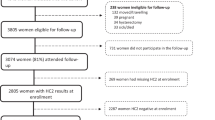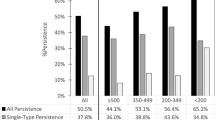Abstract
Objective: The purpose of this investigation was to assess the association between smoking and clearance of oncogenic human papillomavirus (HPV) infection. Methods: A prospective cohort study of 346 women aged 18–35 years was conducted. HPV testing was conducted with the Hybrid Capture II (HC II) system and polymerase chain reaction (PCR) with genotyping using the reverse line blot method. At each visit tobacco exposure, reproductive, and sexual histories were assessed. Probability of clearing an oncogenic HPV infection and duration of oncogenic HPV infections by smoking status was assessed. Results: Regardless of method used, HC II or PCR, ever smokers maintained an HPV infection significantly longer (median duration of 8.5 months vs 10.7 months, never vs ever smokers), and had a lower probability of clearing an oncogenic infection compared with women who never smoked. Smoking duration was significantly associated with HPV clearance, and a dose response was observed. Older age (> 13 years) at smoking initiation was significantly associated with a reduced probability of clearing an oncogenic HPV infection. Conclusion: This is the first study to demonstrate that smoking promotes early cervical carcinogenic events by increasing duration of oncogenic HPV infections and decreasing probability of clearing oncogenic infections.
Similar content being viewed by others
References
Palefsky JM, Holly EA (1995) Molecular virology and epidemiology of human papillomavirus and cervical cancer. Cancer Epidemiol Biomarkers Prev 4: 415–428.
Ho GY, Burk RD, Klein S, et al. (1995) Persistent genital human papillomavirus infection as a risk factor for persistent cervical dysplasia. J Natl Cancer Inst 87: 1365–1371.
Koutsky LA, Holmes KH, Critchlow CW, et al. (1992) A cohort study of the risk of cervical intraepithelial neoplasia grade 2 or 3 in relation to papillomavirus infection. N Engl JMed 327: 1272–1278.
Schiffman MH (1995) New epidemiology of human papillomavirus infection and cervical neoplasia. J Natl Cancer Inst 87: 1345–1347.
Winkelstein W (1986) Cigarette smoking and cancer of the uterine cervix. In: Hoffman D, Harris CC, eds. Mechanisms in Tobacco Carcinogenesis. Banbury report 23. Cold Spring Harbor, NY: Cold Spring Harbor Laboratory, pp. 329–341.
Winkelstein W (1990) Smoking and cervical cancer-current status: a review. Am J Epidemiol 131: 945–957.
Hellberg D, Nilsson S, Haley NJ, Hoffman D, Wynder E (1988) Smoking and cervical intraepithelial neoplasia: nicotine and cotinine in serum and cervical mucus in smokers and non-smokers. Am J Obstet Gynecol 158: 910–913.
Sasson IM, Haley NJ, Hoffman D, Wynder EL, Hellberg D (1985) Cigarette smoking and neoplasia of the uterine cervix: smoke constituents in cervical mucus. N Engl J Med 312: 315–316.
Holly EA, Petrakis NL, Friend NF, Sarles DL, Lee RE, Flander LB (1986) Mutagenic mucus in the cervix of smokers. J Natl Cancer Inst 76: 983–986.
Barton SE, Jenkins D, Cuzick J, Maddox PH, Edwards R, Singer A (1988) Effect of cigarette smoking on cervical epithelial immunity: a mechanism for neoplastic change? Lancet 2: 652–654.
Hildesheim A, Schiffman MH, Gravitt PE, et al. (1994) Persistence of type-specific human papillomavirus infection among cytologically normal women. J Infect Dis 169: 235–240. Effect of smoking on HPV clearance 845
Ho GYF, Bierman R, Beardsley L, Chang CJ, Burk RD (1998) Natural history of cervicovaginal papillomavirus infection in young women. N Engl J Med 338: 423–428.
Giuliano AR, Harris R, Sedjo RL, et al. (2002) Incidence and clearance of type-specific HPV infections: The Young Women's Health Study. J Infect Dis 186: (in press).
Cox TJ, Lorincz AT, Schiffman MH, Sherman ME, Cullen A, Kurman RJ (1995) Human papillomavirus testing by Hybrid Capture appears to be useful in triaging women with a cytologic diagnosis of atypical squamous cells of undetermined significance. Am J Obstet Gynecol 172: 946–954.
Hall S, Lorincz A, Shah F, et al. (1996) Human papillomavirus DNA detection in cervical specimens by Hybrid Capture: correlation with cytologic and histologic diagnoses of squamous intraepithelial lesions of the cervix. Gynecol Oncol 62: 353–359.
Vernon SD, Unger ER, Williams D (2000) Comparison of human papillomavirus detection and typing by cycle sequencing, line blotting, and Hybrid Capture. J Clin Microbiol. 38: 651–655.
Gravitt P, Peyton C, Alessi T, et al. (2000) Improved amplification of genital human papillomaviruses. J Clin Microbiol 38: 357–361S.
Gravitt PE, Payton CL, Apple RJ, Wheeler CM (1998) Genotyping of 27 human papillomavirus types by using L1 consensus PCR products by a single-hybridization, reverse line blot detection method. J Clin Microbiol 36: 3020–3027.
Layde PM (1989) Smoking and cervical cancer: cause or coincidence? JAMA 261: 1631–1633.
Simons AM, Phillips DH, Coleman DV (1993) Damage to DNA in cervical epithelium related to smoking tobacco. BMJ 306: 1444–1448.
Becker TM, Wheeler CM, McGiuough NS, et al. (1994) Cigarette smoking and other risk factors for cervical dysplasia in Southwestern Hispanic and non-Hispanic white women. Cancer Epidemiol Biomarkers Prev 3: 113–119.
Lacey JV Jr, Frisch M, Brinton LA, et al. (2001) Associations between smoking and adenocarcinomas and squamous cell carcinomas of the uterine cervix (United States). Cancer Causes Control 12: 153–161.
Gram IT, Austin H, Stalsberg H (1992) Cigarette smoking and the incidence of cervical intraepithelial neoplasia, Grade III, and cancer of the cervix uteri. Am J Epidemiol 135: 341–346.
Burger MP, Hollema H, Gouww AS, Pieters WJ, Quint WG (1993) Cigarette smoking and human papillomavirus. BMJ 306: 749–752.
Dahling JR, Sherman KJ, Hislop TG, Maden C, Mandelsohn MT, Beckman AM, Weiss NS (1992) Cigarette smoking and the risk of anogenital cancer. Am J Epidemiol 135: 180–189.
Deacon JM, Evans CD, Yule R, et al. (2000) Sexual behaviour and smoking as determinants of cervical HPV infection and of CIN3 among those infected: a case-control study nested within the Manchester cohort. Br J Cancer 88: 1565–1572.
Kjaer SK, Van den Brucle AJC, Bock JE, et al. (1996) Human papillomavirus-the most significant risk determinant of cervical intraepithelial neoplasia. Int J Cancer 65: 601–606.
Kjaer SK, Engholm G, Dahl C, Bock JE (1996) Case-control study of risk factors for cervical squamous cell neoplasia in Denmark. IV: Role of smoking habits. Eur J Cancer Prev 5: 359–365.
Daling JR, Madeleine MM, McKnight B, et al. (1996) The relationship of human papillomavirus-related cervical tumors to cigarette smoking, oral contraceptive use, and prior herpes simplex virus type II infection. Cancer Epidemiol Biomarkers Prev 5: 541–548.
Sassagwa T, Dong Y, Saijoh K, Shin-ichirou S, Masaya T, Masaki I (1997) Human papillomavirus infection and risk determinants for squamous intraepithelial lesion and cervical cancer in Japan. Jpn J Cancer Res 88: 376–384.
Ho GYF, Kadish AS, Burk RD, et al. (1998) HPV 16 and cigarette smoking as risk factors for high grade cervical intraepithelial neoplasia. Int J Cancer 78: 281–285S.
Chichareon S, Herrero R, Munoz N, Bosch FX, et al. (1998) Risk factors for cervical cancer in Thailand: a case-control study. J Natl Cancer Inst 90: 50–57.
Ngelangel C, Munox N, Bosch FX, et al. (1998) Causes of cervical cancer in the Philippines: a case-control study. J Natl Cancer Inst 90: 43–49.
Olsen AO, Dillner J, Skrondal A, Magnus P(1998) Combined effect of smoking and human papillomavirus type 16 infection in cervical carcinogenesis. Epidemiololgy 9: 346–349.
Ylitalo N, Sorensen P, Josefsson A, et al. (1999) Smoking and oral contraceptives as risk factors for cervical carcinoma in situ. Int J Cancer 81: 357–365.
Kjellberg L, Hallmans G, Ahren A-M, et al. (2000) Smoking, diet, pregnancy, and oral contraceptive use as risk factors for cervical intraepithelial neoplasia in relation to human papillomavirus infection. Br J Cancer 82: 1332–1338.
Hildesheim A, Herrero R, Castle PE, et al. (2001) HPV co-factors related to the development of cervical cancer: results from a population-based study in Costa Rica. Br J Cancer 84: 1219–1226.
Ferson M, Edwards, A, Lind A, Milton GW, Hersey P(1979) Low natural killer cell activity and immunoglobulin levels associated with smoking in human subjects. Int J Cancer 23: 603–609.
Barton SE, Jenkins D, Cuzick J, Maddox PH, Edwards R, Singer A (1988) Effect of cigarette smoking on cervical epithelial immunity: a mechanism for neoplastic change? Lancet 2: 652–654.
Moscicki AB, Shiboski S, Broering J, et al. (1998) The natural history of human papillomavirus infection as measured by repeated DNA testing in adolescent and young women. J Pediatr 132: 277–284.
Schlecht NF, Kulaga S, Robitaille J, et al. (2001) Persistent human papillomavirus infection as a predictor of cervical intraepithelial neoplasia. JAMA 286: 3106–3114.
Author information
Authors and Affiliations
Rights and permissions
About this article
Cite this article
Giuliano, A.R., Sedjo, R.L., Roe, D.J. et al. Clearance of oncogenic human papillomavirus (HPV) infection: effect of smoking (United States). Cancer Causes Control 13, 839–846 (2002). https://doi.org/10.1023/A:1020668232219
Issue Date:
DOI: https://doi.org/10.1023/A:1020668232219




